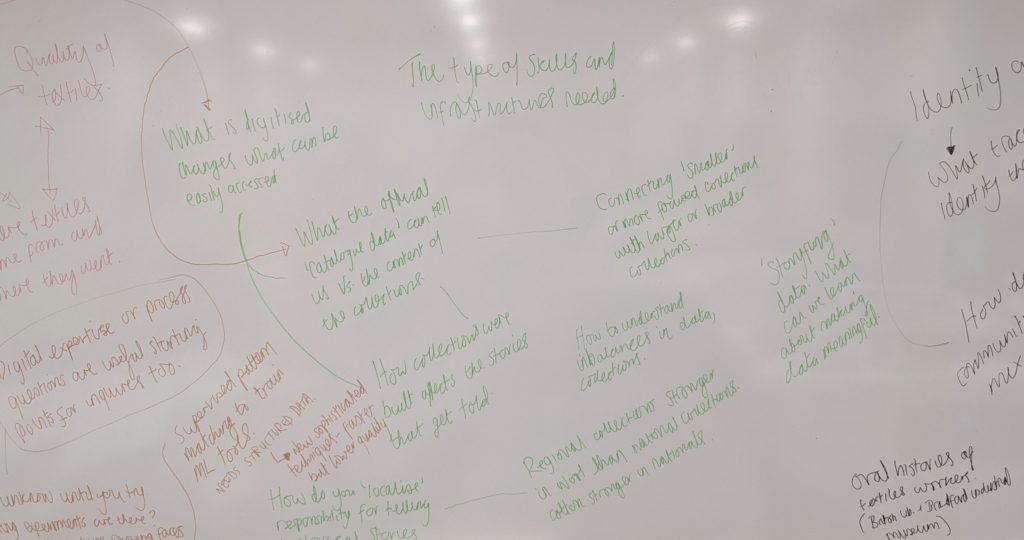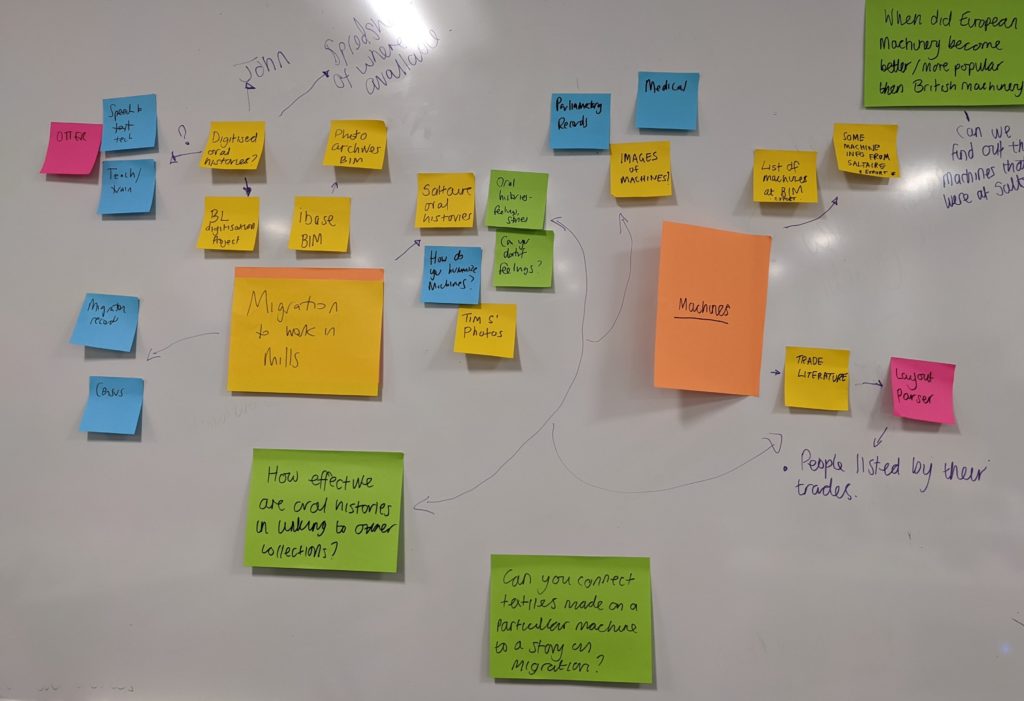Written by Arran Rees and Tim Boon
As the Congruence Engine project develops, travelling through its first major cycle of action research, we have been learning more about the challenges in connecting collections data from different institutions, about the affordances of the different computational tools available to us, and about the complex interplay between technology, data, and people in articulating and undertaking historical inquiries in support of the project’s aims.
On 20th and 21st June, we held our first workshop as part of the textiles strand of the project. The aim was to begin developing a set of co-produced mini-inquiries between people with historical, technical and processual interests, that could be explored over a four-week period. This four-week period, which we tentatively called ‘walking alongside’ is designed to create a facilitated research process, whereby we get to better understand how action-focused inquiries can support our learning about the potential of computation techniques in connecting collections.
We met again on 27th July to draw together and reflect on what we were able to achieve, what challenges we faced, where we felt there was energy and potential, and how the process of running co-produced mini-inquiries has either supported or hindered our collective learning.
For us, the whole process of the two workshops bookending a period of mini-investigations and ‘walking alongside’ represents a whole action research cycle, where the initial workshop on 20/21st June is the ‘plan’ phase, the mini-investigations span the ‘act’ and ‘observe’ phases, and the final workshop at the end of July is the ‘reflect’ phase.

What did we do at the June workshop?
The workshop was set up to be a space for sharing research interests, learning about what might be possible, and for co-developing new research questions at the intersection of historical interest and digital-led inquiry. Using a number of techniques from the Liberating Structures facilitation toolbox, we helped identify mutual areas of interest between workshop attendees, ran blue-sky thinking sessions on utopian research set ups, demonstrated possible computational techniques and worked to create new research inquiries through a group-wide interest clustering exercise.


Whilst we don’t think we can claim all of it ran entirely as expected, we certainly got a lot out of the process, ending the workshop with four tangible and actionable inquiries to get started on. These are:
- How useful are oral histories in linking heritage collections?
- Is it possible to link lists of textiles machinery with trade directory data to help us better understand the types of machines used in Salt’s Mill?
- What sorts of data and tools would be needed to help identify and connect people who worked in the textile industry through photographs?
- Is it possible to create a data model that allows insights into notions of ‘resilience, belonging and bodily damage’ in the Saltaire community?
These inquiries are framed within an overarching question of ‘How can we reinfuse Salt’s Mill and Saltaire (or Lister’s Mill and Mannington) with their social histories?’
We are interested in how heritage collections data can help tell stories, i.e. starting from the textiles machinery data, trade directories data or hospital records to tell wider stories about life in the past; as well as how stories can be used as data to link collections, e.g. oral history collections as touch points for linking to multiple types of heritage data.
Reflections
Arran
What really struck me was that a few of our assumptions about how historical and digital research questions would naturally emerge through facilitating conversation between historically-focused and digitally-focused researchers were not quite right.
It is fair to say that I had imagined that quite specific historically-focused research questions would pop-up as we explored some of the potential digital tools that we could use. However, that didn’t happen as expected. Instead, broad historical topics were suggested, and the formation of research questions was a much more involved and dynamic process between the historians, technologists and action research facilitators in the room. Whilst we had envisaged that the enquiries would be led by one or more of the historians or technologists on the project supported by a facilitator, it worked out that the inquiries are being led by the facilitators, influenced by the interests of the historians and technologists.
Tim
This led me to reflect on what we can expect to occur in the open collaboration we have set up to explore what will be possible historically in a world of linked collections. I think we were naïve to assume that it would be obvious to participants how as-yet unfamiliar digital techniques might enable new kinds of historical enquiry, and it is telling that the one participant who of their sole volition proposed a digital-historical enquiry was a team member (Alex) who already works across digital and historical practice.
What this points to is the need for the projects that we are now embarked upon, which arose from joint discussion across the historical-digital divide. When we have the initial results from these, we will have examples to discuss of the kinds of things that might be possible, and we can use these to stimulate discussion about further possibilities. I look forward to discussions along the lines: ‘if the software can do that, might it be able to do this?’
We should remember that most historical practice is path-dependent in the sense that, whatever kind of historian we are, we have learned to work in particular ways. So, for example, family historians learn how to use Ancestry or Find My Past to build their family trees; university-based historians learn how to derive narratives from scattered archives, some making use of theoretical concepts to sharpen their analyses. All these practices have, to varying extents, already been revolutionised by digital technique; one of our workshop attendees (Colin), for example, is able to do sophisticated social historical analyses of Saltaire and its inhabitants even though he lives in Australia, and this is because of the very rich resources, of the Census etc., that are now available online. But it is well within living memory that anyone wanting to trace their ancestors would have had to go to a particular building in London to look up paper copies of these records. So, we should anticipate that increasing digital resources will create a ‘new normal’ for many kinds of curatorial and historical research. In Congruence Engine we are engaged in co-producing that future.
What happens next?
The reflection workshop took place on 27th July, after a relatively short and intense period of experimentation being led by the facilitators (Stefania Zardini Lacedelli, Cameron Tailford, Alex Butterworth, Arran Rees, Simon Popple, Tim Smith and Paul Craddock – with some major input from Colin Coates, Caroline Perry, John Ashton, Lauren Padget, Maggie Smith and Jonathan Ainsworth). Another blog will follow soon on the outcomes of the investigations and our reflections on them.